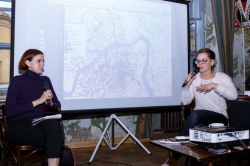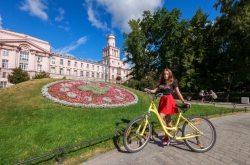Today, the work of the Quality of Urban Life Lab at ITMO’s Institute of Design & Urban Studies is not limited to just research: the lab also develops projects that serve to improve the quality of life in cities. One of the main areas of focus for staff at the lab and urban scientists in general are open public spaces, which play an important role in cities; these spaces are where people meet, socialize and spend their time. According to Alexandra Nenko, head of the Quality of Urban Life Lab, emotions are key to understanding what people enjoy about public spaces, and what makes them afraid, disgusted, or sad.
“Imprecity is an opportunity to talk about St. Petersburg’s emotions, to make decisions and create projects designed to improve the emotional atmosphere of the city and the quality of life. Our research reflects the genuine need for new tools that could assess the quality of urban life from a citizen’s point of view. We based our project on some of the most intriguing units of measurement – emotions. Scientists are often reluctant to trust emotions – they’re untrustworthy, subjective, unverifiable, etc. But this is exactly what our Lab is looking for, because city dwellers act on subjective feelings, not based on rational decision making,”

Even though emotions aren’t favored by the scientific community at large, many international research teams and labs, including giants like MIT and Google, are currently conducting researching on citizens’ emotions. Many online services and apps let users share their emotions; for instance, in apps like Foursquare, Flamp or Google Maps users can check into spots, make comments and rate their experience. Emotion-based services are emerging, as well. For example, Spatial Emotional Awareness (SEA) is a digital gadget that evaluates users’ emotions based on their body temperature and guides them towards others who can help them share positive feelings. The companion app Emotion Map lets users mark spots they like and which evoke in them various emotions. Users can check the map to find interesting spots near them, meet each other based on emotional state and receive personal emotional stats.
Emotionsense is another platform that tracks users’ emotional states throughout the day. The analysis is based on various information that comes from a user’s smartphone, such as voice calls and voice messages. The app analyzes laughter, pauses and voice qualities to determine the user’s emotional state.
Imprecity is currently at the stage of collecting the first wave of data. Experts will analyze this data and compile it into an infographic that will be made publically available by ITMO University and various St. Petersburg media.

“We plan to create emotional rankings of the city’s public spaces; something like “Top 5 Sad Parks” or “The Happiest Embankment”. We’ll identify the public spaces that have been evaluated by users the most and provoke the most emotional response. We’ll also look at the spots that people are indifferent about, “emotional wastelands”, so to say. These spots will most likely consist of former industrial sites and closed-off or abandoned areas, but they may also include some public spaces. One of our other plans is to create “emotional routes”, although that will require a substantial amount of data,” – explains Alexandra Nenko.
The staff of the Lab expects to collect several thousand emotional assessments in order to perform a statistically significant analysis. The researchers say that they also plan to attract more in-depth commentary from citizens and experts and to collect pictures of the places that cause the biggest emotional response so that someday Imprecity might become a full-fledged media for the city’s inhabitants.
Anyone can participate in the research, as at this stage the researchers don’t impose any categorization limits on the participants. Users can log in through VK, Facebook or Google+ and use emoji to mark a specific emotion on the map, as well as leave comments. Imprecity’s analysts regularly update emotional heat maps and suggest places to visit with family and friends.

Even though the project is in Russian, it will also be accessible to any foreigner, as emoticons are universal and comments can be left in any language. Later, the researchers will filter the information left by the city’s inhabitants and tourists based on semantic analysis of comments and information about the most common tourist routes and sights. For instance, evaluations made far from the center of the city are more likely to be made by locals.
The project’s long-term goal is to create suggestions on how to improve the city’s emotional atmosphere, and then to present these ideas to the Government of St. Petersburg. Imprecity is but one instrument of monitoring the quality of life as part of the “Smart St. Petersburg” project. Imprecity is also a “smart” technology that combines data collection with communication between citizens, experts and decision-makers. Results of the research can be shown to city authorities, heads of districts, committees, and urban communities.

Today, Imprecity is serviced by experts from the Quality of Urban Life Lab and the developer team Thinglink, also based at the Institute of Design and Urban Science. That includes staff members of the Lab Alexandra Nenko, Marina Petrova and Artem Konyukhov, and Thinglink employees Alexey Solomatin, Filipp Sher, Andrey Lyubert and Anton Gurkin.
Imprecity is a part of the program “Smart St. Petersburg”, sponsored by the Government of St. Petersburg. The project was presented at the conference Comparative Media Studies in Today's World; a summary of the conference will be published in DTGS Proceedings by Axel Springer Verlag (indexed by SCOPUS).




